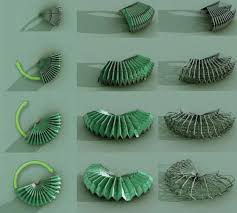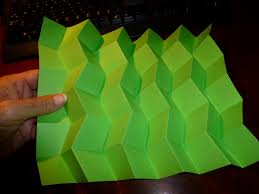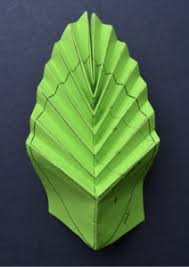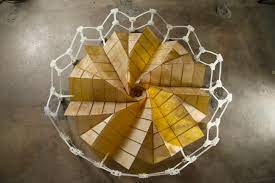Unfolding nature's secrets: mathematics and origami.
- Silvana Lucolli

- Apr 16, 2024
- 2 min read
Updated: Apr 20, 2024
You wouldn't believe the profound impact a deep understanding of garden mathematics can have. Back in 1994, I worked as a documentarist for an independent German film production company. Our task was to develop a television series centered on engineering concepts drawn from nature, aiming for enhanced design efficiency and energy conservation.
The producer and I embarked on a interesting journey, meeting numerous researchers before collaborating with the technical filming team. It was a true honor to encounter Professor Biruta Kresling, renowned for her work in architecture, design and packaging inspired by natural models. She was interested in the intricate folding mechanisms observed in flower buds and closed leaves, which unfold into expansive surfaces with remarkable energy efficiency, left an indelible impression.
Consider a tree emerging from a harsh winter, needing to sprout thousands of new leaves despite the limited light between seasons. How does a plant efficiently allocate energy to carry out these transformations simultaneously?
The study of such mechanisms is not just compelling but essential in the context of our modern era. Plants, with their myriad energy-efficient strategies, are indeed remarkable. Prof. Kresling, was the co-author of the German book 'Erfindungen der Natur - Bionik die Technik lernt von Tieren und Pflanzen' (translated as 'Inventions of Nature - Bionics: Technology Learning from Animals and Plants'), was instrumental in pioneering the exploration of nature-inspired models, particularly in architecture. Biruta had expended years smashing the beauty of nature in Origami structures.
Our journey led us to delve into the intricacies of leaf and flower folds, extending even to vegetables like cabbages, lettuces, and cauliflowers. Under the tutelage of Prof. Kresling, we learned to replicate some of these natural models in paper folds or Origamis. We knew about the Japanese origem of the origami but, could not imagine that we would finish interviewing her tutor Prof. Miura in Japan. Yes, surprisely after Biruta´s meeting we eventually finding ourselves at the Astrophysics and Astronomy Institute at University of Tokyo. There, we encountered Prof. Emeritus Miura, a revered Japanese researcher, who studied leaf folds' geometry, their angles and reproduced them into paper folders. He had smashed thousand and thousand of cans and papers sheets and had studied the pattern of the winkles to finally created the famous origami structure called Miura-Ori. His insights combined with the studies of natural leaf unfolding was inspiring solar panels for satellites, aimed at minimizing energy consumption when opening in space. On those years his ideas were "blooming" and we were so glad for the opportunity to following some of them.
Later, many other applications were found including in cartography, surgical devices, flat-foldable furniture, and electrical storage. Our journey in Tokyo culminated in capturing aspects of Prof. Miura research for a German-French TV series called "Bionik: patente der Natur".
Isn't it fascinating to contemplate the boundless possibilities that a garden can unveil?"
My memories:
Japan (1994) Bioniks crew.
Silvana visiting a Japanese garden, Hokkaido.
Miura-Ori structure.
Prof. Miura studied thousand of wrinkles created in smashed paper sheets.
Prototype of folding structures for solar panels in satellites.






















Comments